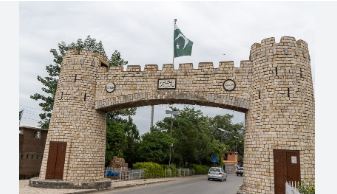PESHAWAR, APR 14 (DNA) — Being a gateway to the subcontinent, Peshawar has always remained a strategic city where kings and invaders of various dynasties constructed historic buildings for their families’ residences to prolong their rule.
Besides Balahisar Fort, historic buildings including Sethi House and Khan Klubs were constructed at the heart of Peshawar City where kings, commanders and monarchs stayed before marching to the subcontinent. Constructed by Mughal rulers in 1800 on Ashraf Road in Peshawar City, Khan Klub was also the main centre of attraction for domestic and foreign tourists due to its boutique style and soothing environment.
However, Khan Klub has started losing its eye-catching ancient architecture and woodwork after it was converted into floor godowns and general stores for monetary gains in the recent past. Located at Hastnagri bazaar near Balahisar fort and Chowk Yadgar, Khan Klub’s four storey building built on five marla land was presently in shamble condition with no facilities for tourist and art lovers for which it was once famous far and required immediate reconstruction and conservation work before it falls.
While passing on Ashraf road near Rampura gate, a visitor would be extremely disappointed after seeing the deteriorating boutique style primitive building with dust on the floor, fodder and materials of daily use commodities.
“Khan Klub is neither a hotel nor a guesthouse or Havalli, but it is a home of centuries-old civilization reflecting Mughal era architecture and traditional craftsmanship and its conservation was need of the hour being an identity of Peshawar”, said Bakhtzada Khan, senior research officer KP archeology and museum department while talking to media.
“Khan Klub was the most preferred choice of foreign tourists and dignitaries for stay at Peshawar due to its peaceful environment, architectural significance and proximity with historical buildings including Balahisar fort, Mohabat Khan mosque and Qissa Khwani bazaar,” he said.
“Before 2,001, booking a room was a herculean task for foreign tourists, ambassadors and missions, who stayed here due to its pleasant atmosphere, mouthwatering cuisines, cultural music and closed location with other historical buildings including Qisa Khwani bazaar, Ghanta Ghar, Mohabat Khan Mosque, Chowk Yadgar, Ghanta Ghar and Sethi House,” he said, adding in its main halls were flooded with tourists where they enjoyed the traditional Peshawari music including Rubab with Tabla.
Tourists explored the historical Chowk Yadgar monument constructed in 1892 after it was dedicated to General Hastings and were highly impressed by the historical Mahabat Khan mosque’s architecture built in the 17th century by the Mughal Governor Mohabat Khan.
Peshawar Museum, which is the lone museum of Gandhara Art with the complete life story of Lord Bhudda housing around 30,000 artifacts and statues has drawn Ghandara art lovers and enjoyed the traditional Peshawari Qehwa at historical Qissa Khwani bazaar in the company of the international story tellers.
Besides cultural programs, he said the tourists enjoyed local traditional music and taste of varieties of foods including the mouthwatering Peshawari Palao, Qahwah (Green Tea), lemongrass tea with an aroma of jasmine, Bengal tea, Kerala coffee and darjeeling spring bud at Qissa Khwani and returned to Khan Klub for night stay.
Bakht Zada said Khan Klub had been formally converted into a full fledged hotel by a local influential Inayatullah Khan with support of an Irish American Martin Jay Davis in 1995 and has soon become the most ideal choice of foreign and domestic tourists. The owners said they were ready to reserve its two upper storey for tourists if the provincial government provides financial support for its repair and renovation.
The architecture and artwork of the historical building were badly affected by earthquakes, torrential rains and changing weather patterns and at least five million would be required for its complete renovation and conservation works. Its sophisticated artwork on exterior and interior designs besides its beautifully designed balconies required immediate renovations before it collapsed. Its eight rooms with different colourful names were different from one another. — DNA

















